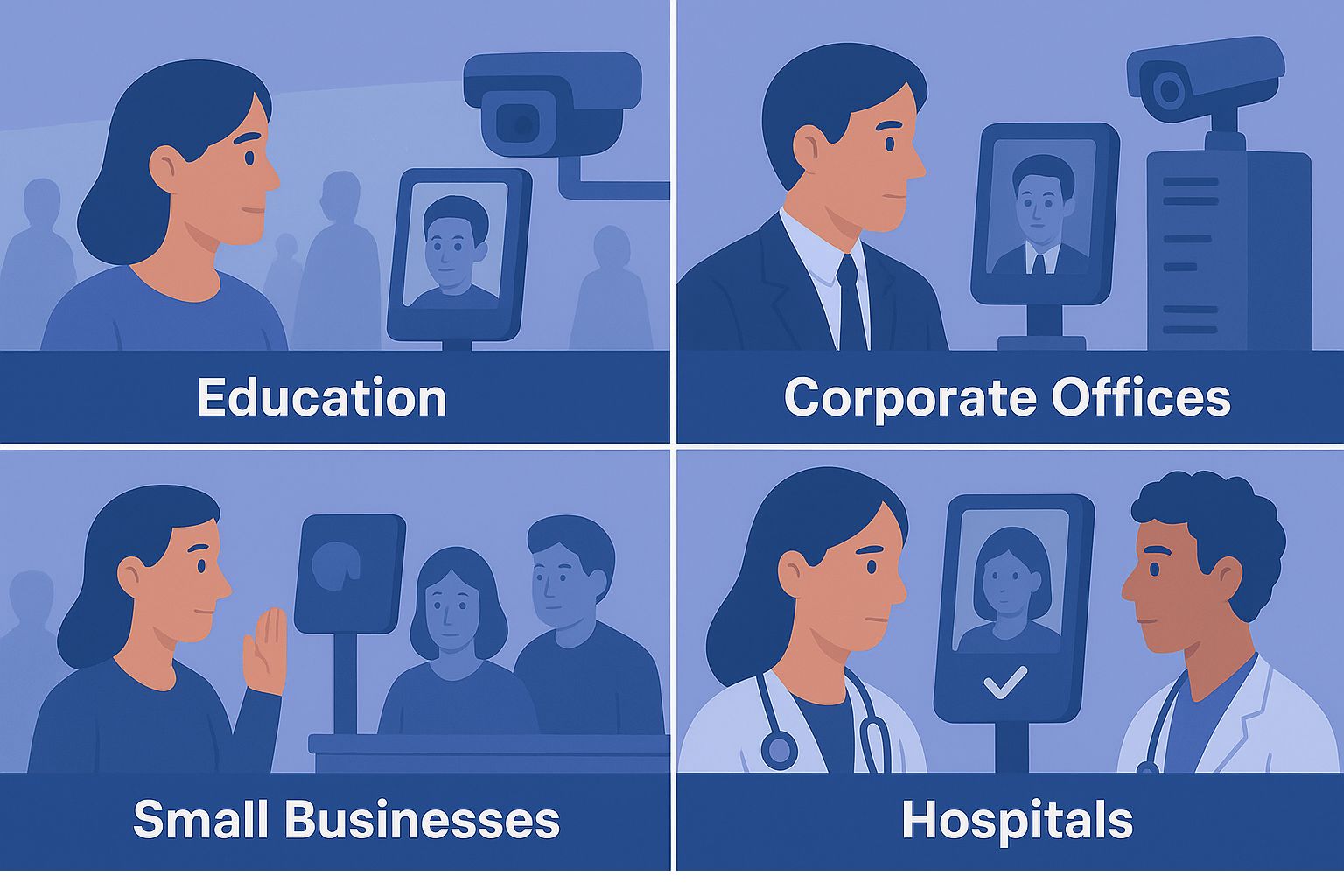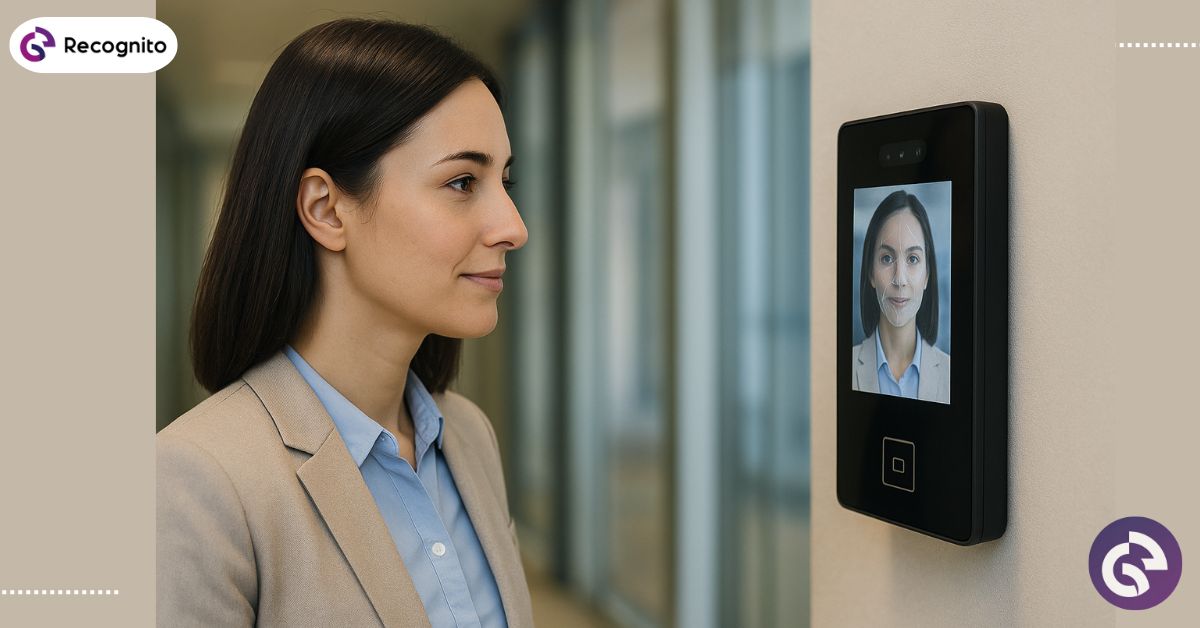Tracking attendance has evolved significantly from the old methods of paper registers and punch cards. Today, organizations are increasingly adopting facial recognition attendance systems to streamline tracking, improve security, and save time. These systems combine advanced face detection attendance system technology with AI to ensure accurate and hassle-free employee management.
With workplaces getting more tech-driven, integrating an AI attendance system not only improves efficiency but also reduces human errors associated with traditional attendance methods. This technology ensures that attendance is accurate, instantaneous, and tamper-proof, offering a significant upgrade over legacy systems.
What is a Facial Recognition System for Attendance
A facial recognition system for attendance uses biometric technology to identify individuals based on their unique facial features. Unlike cards or fingerprint scanners, face recognition offers touch-free verification, making it quicker and more sanitary.
These systems capture the user’s face using cameras and match it against a stored database. The system analyzes unique facial features, such as eye spacing, nose structure, and jaw contours, to confirm a person’s identity. Modern AI-powered systems even adapt to changes in lighting, angle, and facial accessories like glasses or masks.
Key Features of a Facial Recognition System for Attendance
- Contactless Verification: Reduces physical touchpoints, improving hygiene.
- High Accuracy: Advanced algorithms minimize false positives and negatives.
- Real-Time Tracking: Attendance logs update instantly.
- Integration with Payroll: Automatically syncs attendance data with payroll systems.
- Multi-Device Support: Works on cameras, smartphones, and tablets.
A study by NIST FRVT highlights the high accuracy rates of modern facial recognition algorithms, proving their reliability in real-world applications. For detailed technical insights, you can check their Face Recognition Technology Evaluation.
Benefits of Using a Face Detection Attendance System
Switching to a face detection attendance system offers several benefits for organizations, large or small:
- Time Efficiency: Employees no longer wait in lines to clock in. Attendance is recorded within seconds.
- Reduced Buddy Punching: Eliminates the risk of proxy attendance since the system identifies each individual uniquely.
- Enhanced Security: Only authorized personnel can gain access to the premises.
- Data Analytics: Offers detailed insights into attendance trends, overtime, and staff punctuality.
- Cost Savings: Cuts down administrative work and prevents errors in manual attendance management.
AI-Based Face Recognition Attendance System in Modern Workplaces
The rise of AI has transformed traditional face recognition systems into AI-based face recognition attendance systems. These solutions not only identify faces but also analyze patterns, detect anomalies, and prevent fraud.
For instance, AI algorithms can detect if someone is trying to spoof the system using a photo or video. This adds an extra layer of security that older systems lacked. Additionally, AI models continuously learn from new data, improving their accuracy over time.
Companies implementing AI attendance systems have reported up to 30% reduction in payroll errors and significant improvements in attendance management efficiency.
Face Recognition Time Attendance vs Traditional Methods
| Feature | Traditional Methods | Face Recognition Time Attendance |
| Verification Speed | Slow (manual punch cards) | Instant (seconds per employee) |
| Contactless | No | Yes |
| Accuracy | Prone to errors | High accuracy with AI algorithms |
| Security | Vulnerable to proxy | Secure and tamper-proof |
| Integration | Manual processing | Automated with payroll and HR tools |
Switching to a face recognition time attendance system modernizes workplace management while improving employee experience and operational efficiency.
Implementing a Facial Recognition Attendance System
Setting up a facial recognition attendance system needs thoughtful preparation:
- Assess Needs: Identify the number of employees, office layout, and data management requirements.
- Choose the Right Software: Select software that is AI-driven, scalable, and compatible with your current HR systems.
- Hardware Setup: High-quality cameras and controlled lighting improve recognition accuracy.
- Training & Onboarding: Educate staff about system usage and privacy measures.
- Regular Audits: Monitor accuracy and performance regularly to ensure reliability.
Organizations that implement these steps experience smoother adoption and minimal disruptions.
Use of Facial Recognition Attendance System in Different Industries
Facial recognition attendance systems are versatile and can benefit a wide range of industries, from education to healthcare. This is how various industries are putting this technology to use:
Education: Colleges and Schools
- Schools and colleges implement facial recognition system for attendance to automate class attendance, reduce buddy punching, and maintain secure campuses.
- Real-time tracking helps identify latecomers and monitor classroom occupancy efficiently.
Corporate Offices
- Large companies use AI attendance systems to streamline employee check-ins and integrate with payroll.
- Face recognition time attendance ensures only authorized personnel access sensitive areas.
Small Businesses
- Small businesses benefit from reduced administrative overhead with face detection attendance systems.
- These systems require minimal hardware, making them cost-effective while still accurate.
Hospitals
- Medical facilities adopt AI-based face recognition attendance systems to track doctors, nurses, and staff shifts accurately.
- Contactless verification also reduces infection risks in sensitive environments.
Banks and Financial Institutions
- Banks use facial recognition attendance systems to secure entry points and monitor staff presence efficiently.
- Integrating attendance data with HR systems ensures compliance and improves operational reporting.
Across all these industries, facial recognition attendance systems provide a reliable, secure, and efficient method for managing workforce attendance while reducing errors and administrative work.

Case Study: Efficiency Gains from AI Attendance Systems
A mid-sized tech company in the US replaced their fingerprint-based attendance system with an AI attendance system. Within three months:
- Attendance errors dropped by 85%.
- Payroll processing time reduced by 50%.
- Employee satisfaction improved due to reduced waiting times and contactless check-ins.
This shows how integrating a facial recognition system for attendance directly impacts operational efficiency.
Common Challenges and Solutions
Even with advanced technology, some challenges may arise:
- Lighting Variations: Use cameras with wide dynamic range or adjust indoor lighting.
- Mask or Accessories: AI algorithms trained with partial face data can still recognize employees.
- Data Privacy: Store data securely, follow local regulations, and inform employees about usage.
By addressing these challenges proactively, organizations can fully leverage the benefits of a modern AI-based face recognition attendance system.
Conclusion
A facial recognition attendance system is more than a convenience; it’s a strategic investment that improves accuracy, efficiency, and security in workforce management. From face detection attendance systems to face recognition time attendance, integrating AI transforms how organizations track attendance.
For organizations looking to adopt cutting-edge solutions, learning from NIST FRVT evaluations can guide technology selection. Recognito offers solutions that combine advanced AI with user-friendly implementation, making it easier for businesses to adopt modern facial recognition attendance systems without hassle.
Explore more at Recognito GitHub for tools and resources related to AI attendance management.
Frequently Asked Questions
1. How accurate are facial recognition attendance systems?
Modern AI-based systems can achieve over 99% accuracy. Accuracy may vary slightly depending on lighting, camera quality, and employee positioning.
2. Can facial recognition systems work with masks or glasses?
Yes. Advanced algorithms recognize partial faces, so verification works even when employees wear masks, glasses, or hats.
3. Are facial recognition attendance systems safe and secure?
Yes. Data is encrypted, access is restricted to authorized personnel, and AI prevents spoofing or fraud attempts.
4. How do facial recognition systems compare to traditional methods?
They are faster, contactless, more accurate, and prevent buddy punching. Integration with payroll and HR systems also saves time and reduces errors.
5. Which industries benefit most from facial recognition attendance systems?
Schools, colleges, corporate offices, banks, hospitals, and small businesses use these systems to improve attendance tracking, security, and operational efficiency.

